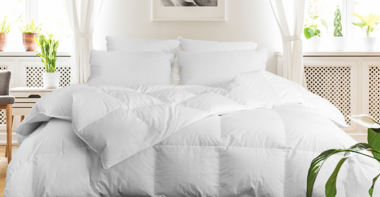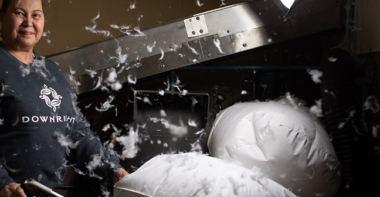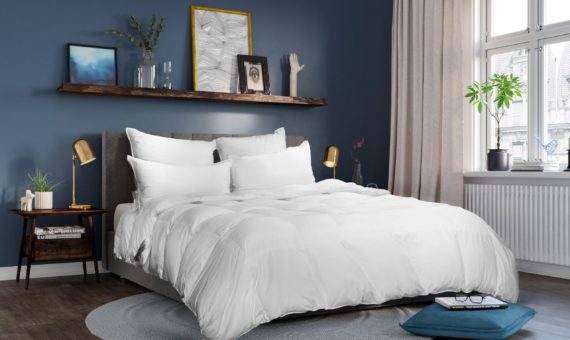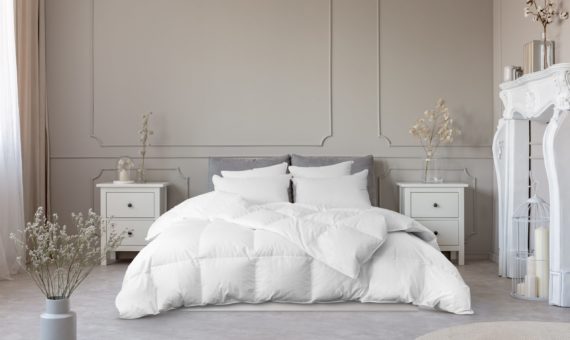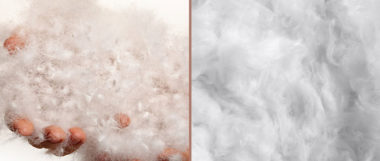Is Down Hypoallergenic?
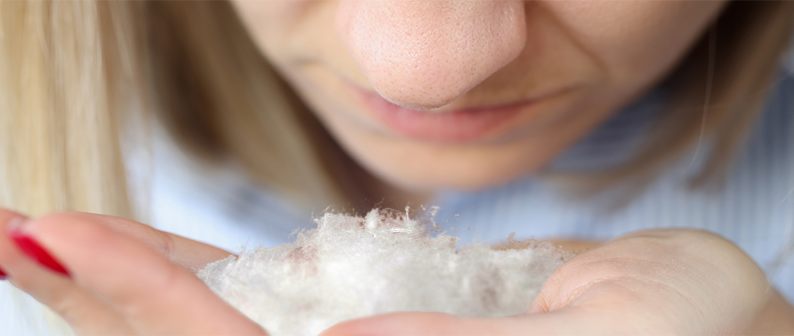
You suffer from allergies and asthma, so, naturally, you are considering down alternative bedding over pure down. But are you denying yourself the sleep of your dreams simply because of a lack of proper down education?
Presumably, this choice has been influenced by great marketing. Manufacturers of hypoallergenic pillows sell their products on the idea that every other product on the market contains some kind of allergenic property in it, aside from theirs.
Hold it- don’t get rid of your down pillows just yet. We are putting the allergy myth to bed so you can rest better.
The Enemy is Dust Mites, not Down
Testing the two types of bedding side by side lays that myth to rest. Dr. Nabeel Farooqui, an allergist at the Ohio State University Wexner Medical Center, says it’s not the down or feathers that tickles your nostrils.
Feathers and down, the natural protectors of birds, have absolutely no allergenic properties.
It’s actually what rests between the feathers that start the itching. Pores in the bedding are the perfect grounds for bacteria and germs, most commonly dust mites to build their home. Thriving on the dead skin cells you shed when you beauty sleep, the dust mites families grow enthusiastically. These invisible pests are what causes the allergic reactions that disrupt your bedroom serenity, such as a runny nose or persistent sneezing.
Are Dust Mites Found in Down Alternatives?
Yet dust mites don’t only choose to make your down pillows their home. The down alternative (or synthetic) bedding provides the same breeding grounds for these enemies of allergy sufferers. What might surprise you further is that the so-called anti-allergen bedding can actually be a greater cause of allergic reactions than the down feathers. Since the synthetics are loosely woven, they allow for many more dust mites, dander and mold spores to aggregate.
Has your bedding not been washed since you’ve purchased it?
Has your comforter been stored under the steps with your boots over the summer?
Are you and your pillow celebrating your 5th anniversary?
If you are nodding your head to any of the questions, you may be causing yourself an unnecessary allergy flare. Read on to learn more about caring for your bedding to avoid reactions.
Downright is Safe for Everyone
Choosing the right down product can give you comfort without the itches.
The first step to an allergy-free rest is choosing the pure and premium down clusters. Next, is giving them a proper washing. High quality down is cleansed thoroughly to ensure that there are as few allergy- inducing particles on the feathers as possible. Our OXI-D process® exceeds the hypoallergenic standards. Each down lot undergoes 2 washes and 4 rinses with a mix of water, soap, and gentle, eco-friendly washers.
Washed lots are then tested for our minimum turbidity number of 550, exceeding the industry’s minimum of 300.
Down is then tested for our maximum oxygen number of 3.2 (Industry’s passable max. is 10)
Next, down that fails to meet our exceptional standards is reprocessed until it exceeds all requirements.
Once the down has passed the initial test, it goes through a drying period. Intense 200°C heat opens the down clusters; finalizes sterilization; and curls up any feathers for extraction.
To end the process with pure, plush, hypoallergenic down, machine-controlled dedusting draws excess fibers and any remaining dust.
Make an educated purchase to maintain your health and happiness.
Care Makes Comfort
Ultimately, the only way to ensure your room remains a haven of clarified comfort and relaxation, is by knowing the proper methods of care and acting on it.
- Wash regularly-This is perhaps the most important. Clean your down articles periodically according to the care label instructions. This will keep the inevitable dust mites to a minimum.
- Reduce humidity– It recommended that you air out your comforter to reduce any accumulation of moisture, which makes dust mites feel more at home. This can be done by hanging it out periodically, folding back the duvet every morning, or opening the windows of your room.
- Maintain carpets– Ideally, carpets should be removed from a home where any of the occupants are allergic to dust mites. If you cannot part with the warmth it provides, use a vacuum cleaner with a high efficiency filter or a central vacuum cleaner. Wash rugs in hot water regularly.
- Dust often– Use a damp mop or cloth to remove the dust in your room while reducing the dust that gets stirred up in the air when using traditional feather dusters.
- Protect bedding– Cover your mattress, pillows and comforter with zippered protectors to keep the mites away. Additionally, using bed linen that is 100% natural cotton will allow the down to breathe.
With the proper care, you don’t have to choose between ultimate relaxation and uncomfortable reactions. Downright exceeds the proper measures taken to ensure that the down is hypoallergenic.
(images- 1-happy woman lying on bed 2-something conveying allergy free down 3-down clusters)
